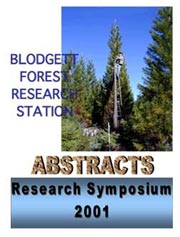ABSTRACT 25
US Forest Service, Genetic Resource Program for California – an Introduction
Paul Stover
Central Zone Geneticist, Placerville Nursery, 2375 Fruitridge Road, Camino, CA 95709, (530) 642-5000
|
|
|
 The Genetic Resource Program for the National Forest System within California began with the selection and propagation of blister rust resistant sugar pine in the 1950’s. A master plan was produced by Dr Jay Kitzmiller and approved in 1976. Vigorous, disease and insect free "superior selections" followed for sugar pine and other important conifers as part of a Tree Improvement Plan in the 1970’s and 80’s. A central office and major orchard site exists at the Genetic Resource Center in Chico. Two zone offices exist in Yreka and Placerville. Three important orchard facilities also exist at the Foresthill Genetics Center, Badger Hill Arboretum, near Placerville and the Happy Camp Arboretum and Disease Resistance Evaluation Garden. Personnel practice their skills in genetics, horticulture, forestry and related fields in a wide variety of projects involving many cooperators both within and outside the agency. The Genetic Resource Program for the National Forest System within California began with the selection and propagation of blister rust resistant sugar pine in the 1950’s. A master plan was produced by Dr Jay Kitzmiller and approved in 1976. Vigorous, disease and insect free "superior selections" followed for sugar pine and other important conifers as part of a Tree Improvement Plan in the 1970’s and 80’s. A central office and major orchard site exists at the Genetic Resource Center in Chico. Two zone offices exist in Yreka and Placerville. Three important orchard facilities also exist at the Foresthill Genetics Center, Badger Hill Arboretum, near Placerville and the Happy Camp Arboretum and Disease Resistance Evaluation Garden. Personnel practice their skills in genetics, horticulture, forestry and related fields in a wide variety of projects involving many cooperators both within and outside the agency.
Opportunities for using even disease resistant seed have substantially declined with the changing emphasis in forest management practices within public lands. However, an important collection of genetic diversity for sugar pine, ponderosa pine, Douglas fir, white fir and other conifers has resulted from the program’s effort.
It is estimated more than 15,000 individual sugar pine parent seed collections are currently stored at 0º C at the Placerville Nursery. For ponderosa pine, Douglas fir, and white fir up to a thousand individual tree seed collections for each species have been collected from northern California. A smaller number of pollen collections exist for ponderosa pine, sugar pine and Douglas fir. More than 600,000 seedlings have been planted in nearly a hundred progeny evaluations. Finally, 270 acres of grafted orchard have been established for ponderosa pine, Douglas fir, sugar pine and white fir. These collections are unique in their breadth of sampling the conifer genetic diversity in the state. They continue to present many opportunities for the study of genetic diversity, disease resistance, basic biology and promoting education for these important conifers.
|

 The Genetic Resource Program for the National Forest System within California began with the selection and propagation of blister rust resistant sugar pine in the 1950’s. A master plan was produced by Dr Jay Kitzmiller and approved in 1976. Vigorous, disease and insect free "superior selections" followed for sugar pine and other important conifers as part of a Tree Improvement Plan in the 1970’s and 80’s. A central office and major orchard site exists at the Genetic Resource Center in Chico. Two zone offices exist in Yreka and Placerville. Three important orchard facilities also exist at the Foresthill Genetics Center, Badger Hill Arboretum, near Placerville and the Happy Camp Arboretum and Disease Resistance Evaluation Garden. Personnel practice their skills in genetics, horticulture, forestry and related fields in a wide variety of projects involving many cooperators both within and outside the agency.
The Genetic Resource Program for the National Forest System within California began with the selection and propagation of blister rust resistant sugar pine in the 1950’s. A master plan was produced by Dr Jay Kitzmiller and approved in 1976. Vigorous, disease and insect free "superior selections" followed for sugar pine and other important conifers as part of a Tree Improvement Plan in the 1970’s and 80’s. A central office and major orchard site exists at the Genetic Resource Center in Chico. Two zone offices exist in Yreka and Placerville. Three important orchard facilities also exist at the Foresthill Genetics Center, Badger Hill Arboretum, near Placerville and the Happy Camp Arboretum and Disease Resistance Evaluation Garden. Personnel practice their skills in genetics, horticulture, forestry and related fields in a wide variety of projects involving many cooperators both within and outside the agency.